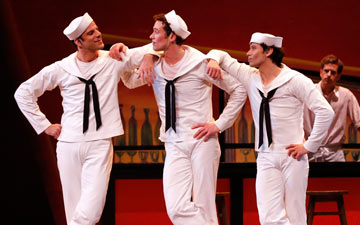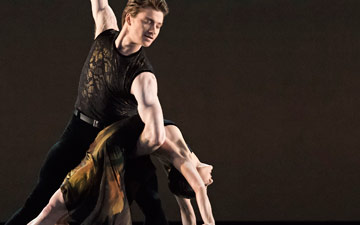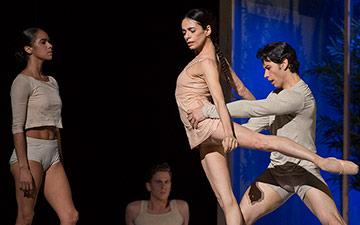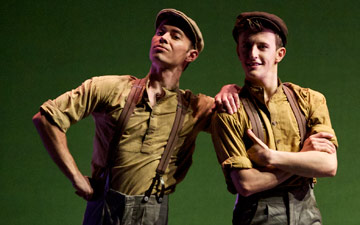
© Rosalie O’Connor. (Click image for larger version)
American Ballet Theatre
Sinfonietta, With a Chance of Rain, Thirteen Diversions
Raymonda Divertissements, Seven Sonatas, Fancy Free
New York, David H. Koch Theater
24 and 25 (mat) October 2014
www.abt.org
Take Two
Casting is destiny. With a new group of dancers, a ballet is subtly transformed. A few nights ago, when Liam Scarlett’s new work With a Chance of Rain opened at ABT, certain passages were so jarring that they made the whole ballet look out of whack. On second viewing, with a different set of dancers, the balance shifted. Which isn’t to say it’s a great ballet, or even the best Scarlett has made for a New York company. But it has its moments. Somberly lit and set to Rachmaninoff piano pieces – lushly played by Emily Wong – it immediately sets a disquieting mood, like the heaviness before a storm. Stormy weather seems to be Scarlett’s preferred habitat. Critics have compared the work to Jerome Robbins’ Dances at a Gathering; if so, it’s as if Dances had been set in an unhappy corner of the planet, for a group of lost souls.
When the fog lifts, temporarily, things get frisky. During a tango-like duet, the man places his hands on his partner’s breasts and jiggles them; later she does the same to him, while also shaking her comely derrière. Then, the woman is replaced by a man. A moment of awkwardness ensues as the two men dust themselves off. The first cast (Misty Copeland and James Whiteside) played up the sexual nature of the gesture; the second (Sarah Lane and Thomas Forster), its silliness. The latter approach works better. The tone is more ironic (though not particularly funny), and therefore inoffensive.
As a result, other aspects of the ballet stand out more, including Scarlett’s twisting, sculptural use of the upper body, particularly for the central male figure, danced here by Cory Stearns. (His height and wingspan add to the effect.) This weighted, push-and-pull dynamic is again put to use in an aggressive male pas de deux danced by Stearns and Thomas Foster, a wrestling match between titans. The final pas de deux, too, is a kind of faceoff, this time between the sexes. Though it overindulges in twisted lifts and balletic clichés regarding male-female dynamics, here, too, a new set of dancers changes the overall effect. In contrast to Seo’s delicacy, Isabella Boylston’s more stylized, aloof approach shifts the power in her favor. The pas de deux is less brutal, more erotic. Stearns and Boylston are a good match; let’s hope the pairing sticks.

© Marty Sohl. (Click image for larger version)
On the evening of Oct. 24, With a Chance of Rain was performed alongside a revival of Jiri Kylian’s 1978 Sinfonietta and Christopher Wheeldon’s Thirteen Diversions. The latter is a prime example of Wheeldon’s chic, super-polished, and highly musical style. The dancers look marvelous in it. Sinfonietta, an early work by Kylian, is set to music by his countryman, Leos Janacek. It has one of the most exhilarating openings I’ve seen in a ballet: men flying across the stage in enormous leaps as a fanfare for twenty-five brass players rings out. The fanfare is repeated at the end; this time, the women (in soft slippers) leap alongside the men. Both image and sound are exalted: strong, pure-hearted souls soaring toward the heavens. The rest of the ballet is somewhat less engaging; musical cues are missed and the folk-dance elements are a tad generic. But it hardly matters.
The new staging of Raymonda Divertissements staged by Irina Kolpakova returned at the Oct. 25 matinée, with a second lineup. It was a more lively performance than the one on opening night, though the ensembles could still use more zip. Devon Teuscher stood out for her serenity and aplomb during a tricky solo full of slow turns ending in arabesque and traveling hops on pointe. In fact, everything is tricky in this ballet. Gillian Murphy polished off the exotic Hungarian solo with style, luxuriating in the tilts that melt into long chains of bourrées as if the ballerina were being pulled back against her will by the flickering notes of the piano. Murphy’s crackling musicality and the proud cast of her chin only added to the effect.
It was good to see Alexei Ratmansky’s Seven Sonatas again. This ballet for three couples is as poetic as ever, and beautifully constructed. Motifs one barely notices at the beginning – a hand reaching out to stop another dancer, a knee lifted to the chest in grief – return, like memories. Each dancer registers clearly: Cornejo’s clean, crystalline jumps and warmth; Julie Kent’s quiet gravity; Joseph Gorak’s legato line. Symmetry alternates with asymmetry, pure dance with hints of narrative. One pas de deux – limpidly danced by Stella Abrera and Calvin Royal III–progresses from serenity and lyricism to loss. The two end up side by side, on their knees. For all the ballet’s joyfulness, death hovers nearby. Seven Sonatas begins in light and closes in darkness.
What better way to end, then, than with Jerome Robbins’ high-spirited Fancy Free, the 1944 precursor to the musical On the Town, now being revived on Broadway. The matinée featured a young cast, with two new sailors, James Whiteside and Eric Tamm, joined by Daniil Simkin. They acquitted themselves well, despite a snafu during the slow dance at the bar. Compared to an earlier cast of veterans, this was a more eager, antic trio, less individualized but more musically precise, emphasizing the jazziness of Leonard Bernstein’s score.
Come to think of it, the orchestra, under the baton of Charles Barker, played up the jazziness of the music as well; maybe it’s because they’ve been playing Sinfonietta, but the horns sounded grand.

















You must be logged in to post a comment.